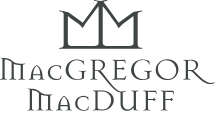Handfasting is an ancient Celtic tradition that dates back to 7000 B.C. Traditionally, when two people were brought to be married, a cord or piece of material was used to bind the couple’s hands together during the ceremony. This symbolised the joining of two lives and is where the expression ‘tying the knot’ comes from. Ancient Celtic law would see this union as a trial period that lasted for one year and one day which would ensure the couple was ready for the commitment of marriage. It was also seen as a public declaration of intent to marry which would let any potential suitors know that both parties were ‘off the market’.
These days, a handfasting ceremony is a little less official but has become a popular addition to Scottish weddings. It’s a poetic way to bring in a touch of Scottish tradition into a modern wedding. During the ceremony, the officiant will ask the groom to place his right hand on his bride's right hand and his left on her left, finally placing both sets of hands on top of each other. The officiant will then take the handfasting material, which is usually two tartan handfasting ribbons, and wrap it around their hands. As the officiant does this, they will usually explain the ritual and how each tartan handfasting ribbon represents the joining of two lives. Once the couple's hands are bound, many opt to exchange their vows as following the handfasting ceremony is the exchanging of the rings.

A handfasting ceremony isn't exclusive for weddings these days. You can have a handfasting ceremony to celebrate any special moment. Whether it be to celebrate the choice to move in together or to commemorate an anniversary, a handfasting ceremony is a fantastic way to mark a special occasion.
The beauty of using tartan ribbons for a handfasting ceremony is that because two ribbons are needed, both the groom and bride get to choose their own tartan. The tartan is usually symbolic to each family so often, if both parties have Scottish surnames, a Clan tartan can be chosen from each side. This will then symbolise the joining of two Clans as well as two lives. If only one or neither have Scottish surnames then the tartan can be chosen to match the groom's kilt or even the wedding décor, which is just as appropriate.

At MacGregor and MacDuff we have over 4,000 different tartans to choose from for your tartan handfasting ribbons. Whether you’d like to opt for a Clan tartan or a universal tartan, you’ll be sure to find the perfect tartans for your handfasting ceremony.
We are passionate about helping create dream weddings at MacGregor and MacDuff. That’s why we offer grooms our Wedding Party Service where we take care of all the fine details so you can concentrate on the big day. This includes making sure all of the groomsmen are measured and that the outfits are collected on time. We also walk you through all the tartan accessories available for the wedding, like Tartan Handfasting Ribbons. We also give grooms the option to receive their most expensive wedding party hire free of charge when purchasing their wedding outfit or if the groom hires 5 outfits from us, they will get £100 off their hire bill.
If you have any questions about our Wedding Party Service or our Tartan Handfasting Ribbons, feel free to contact us at info@macgregorandmacduff.co.uk.

